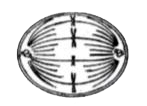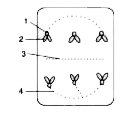Plant cells and animal cells are exactly the same.
Step-by-Step Solution:
1. Understanding the Statement: The statement claims that plant cells and animal cells are exactly the same. We need to evaluate this claim by examining the similarities and differences between the two types of cells.
2. Identifying Similarities: Both plant and animal cells share some common structures, such as:
- Cell membrane
- Nucleus
- Cytoplasm
- Mitochondria
- Ribosomes
3. Identifying Differences: Despite the similarities, there are significant differences between plant and animal cells:
- Cell Wall: Plant cells have a rigid cell wall made of cellulose, while animal cells do not have a cell wall; they only have a flexible cell membrane.
- Vacuoles: Plant cells typically contain one large central vacuole that stores water and maintains turgor pressure. In contrast, animal cells have several small vacuoles.
- Plastids: Plant cells contain plastids (like chloroplasts) that are involved in photosynthesis, whereas animal cells do not have plastids.
4. Conclusion: Given the differences outlined above, we can conclude that the statement "Plant cells and animal cells are exactly the same" is incorrect. While there are similarities, the differences are significant enough to prove that they are not the same.
Final Answer:
The statement that plant cells and animal cells are exactly the same is wrong. They have similarities, but the differences, such as the presence of a cell wall and plastids in plant cells and the absence of these structures in animal cells, highlight that they are not identical.
---
- Cell membrane
- Nucleus
- Cytoplasm
- Mitochondria
- Ribosomes
- Cell Wall: Plant cells have a rigid cell wall made of cellulose, while animal cells do not have a cell wall; they only have a flexible cell membrane.
- Vacuoles: Plant cells typically contain one large central vacuole that stores water and maintains turgor pressure. In contrast, animal cells have several small vacuoles.
- Plastids: Plant cells contain plastids (like chloroplasts) that are involved in photosynthesis, whereas animal cells do not have plastids.
The statement that plant cells and animal cells are exactly the same is wrong. They have similarities, but the differences, such as the presence of a cell wall and plastids in plant cells and the absence of these structures in animal cells, highlight that they are not identical.
Topper's Solved these Questions
- PRACTICE ASSIGNMENTBOOK - ICSECHAPTER - PRACTICE ASSIGNMENTEXERCISE - PRACTICE ASSIGNMENT 2 (Based on Chapter 3 - The Cell) (Answer the following questions :)
8 Videos
- PRACTICE ASSIGNMENTBOOK - ICSECHAPTER - PRACTICE ASSIGNMENTEXERCISE - PRACTICE ASSIGNMENT 2 (Based on Chapter 3 - The Cell)(Mark ( T)for correct and (F) for incorrect statements.)
7 Videos
- PRACTICE ASSIGNMENTBOOK - ICSECHAPTER - PRACTICE ASSIGNMENTEXERCISE - PRACTICE ASSIGNMENT 2 (Based on Chapter 3 - The Cell) (Fill in the blanks with appropriate words : )
8 Videos
- HEALTH AND HYGIENE BOOK - ICSECHAPTER - HEALTH AND HYGIENE EXERCISE - Think and answer
3 Videos
- RESPIRATORY SYSTEM BOOK - ICSECHAPTER - RESPIRATORY SYSTEM EXERCISE - TEST YOURSELF (VII. Answer the following quesitons )
3 Videos
Similar Questions
Knowledge Check
Plant cells differ from animal cells in having
Acell wallBplastidsCa large central vacuoleDAll of thesePlant cells differ from animal cells in having :
AmitochondriaBcell wallCribosomesDGolgi bodies
Plant cell differs from animals cell by
View SolutionIn which of the following features bacterial cells, plant cells and animal cells show similarity?
View SolutionThe diagram given below represents a stage during cell division
Study the same and answer the questions that follow :

Identify whether it is a plant cell or an animal cell। Give a reason in support of your answer.
View SolutionThe diagram given below represents a stage of a cell:

Name the stage.
Is it a plant cell or animal cell? Give a logic reason.
Label the parts 1-4
View SolutionPlant and animal cell divisions differ in
View SolutionWhich of the following microbes transform normal plant and animal cells to cancerous cells respecively ?
View Solution
